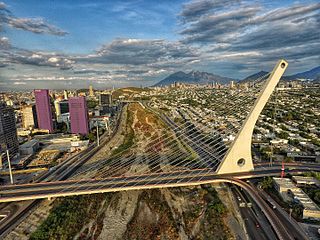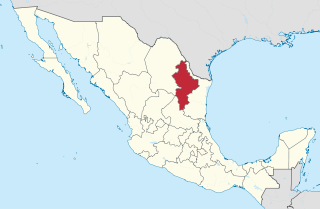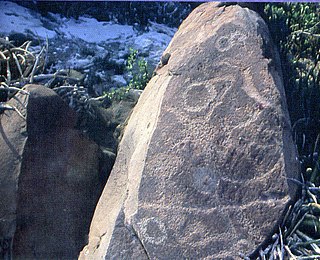
Monterrey is the capital and largest city of the northeastern state of Nuevo León, Mexico, and the second largest city in Mexico behind Mexico City. Located at the foothills of the Sierra Madre Oriental, the city is anchor to the Monterrey metropolitan area, the second-largest in Mexico with an estimated population of 5,341,171 people as of 2020 and the second most productive metropolitan area in Mexico with a GDP (PPP) of US$140 billion in 2015. According to the 2020 census, the city itself has a population of 1,142,194.

Nuevo León is a state in Mexico. The state was named after the New Kingdom of León, an administrative territory from the Viceroyalty of New Spain, itself was named after the historic Spanish Kingdom of León. With a total land area of 64,555 square kilometers, Nuevo León is the 13th largest federal entity in Mexico. The state is located in the northeastern part of Mexico and is bordered by Tamaulipas to the east, Coahuila to the west, and both Zacatecas and San Luis Potosi to the south. To the north, it shares an extremely narrow international border with the U.S. state of Texas. The Laredo-Colombia Solidarity International Bridge is the only vehicular bridge that connects the United States with the state of Nuevo León. It crosses over the Rio Grande between the city of Colombia, Nuevo León, and Laredo, Texas.

San Nicolás de los Garza, sometimes known only as San Nicolás, is a city and coextensive municipality in the Mexican state of Nuevo León that is part of the Monterrey metropolitan area. It has become primarily a city for residences and family houses, although it still has several factories that tend to relocate to the periphery of the metropolitan area. It is the fifth-largest city in the state, behind Monterrey, Guadalupe, Ciudad Apodaca and General Escobedo.

The Autonomous University of Nuevo León is a public university with seven campuses across the northern Mexican state of Nuevo León. Founded as University of Nuevo León on 25 September 1933, it is the third largest public university in Mexico in terms of student population and the most important institution of higher learning in Northeastern Mexico, which offers the highest number of academic programs. It is also the oldest university in the state, it is currently headquartered in San Nicolás de los Garza, a suburb of Monterrey.
The following is a timeline of the history of the city of Bogotá, Colombia.
The following is a timeline of the history of the city of Guadalajara, Mexico.
The following is a timeline of the history of the city of Albuquerque, New Mexico, US.
The following is a timeline of the history of the city of Guanajuato, Mexico.
The following is a timeline of the history of the city of Chihuahua, Mexico.
The following is a timeline of the history of the city of Mérida, Yucatán, Mexico.
The following is a timeline of the history of the city of Puebla, Mexico.
The following is a timeline of the history of Aguascalientes City, Mexico.
The following is a timeline of the history of the city of Ciudad Juárez, Chihuahua, Mexico.
The following is a timeline of the history of the city of León, Guanajuato, Mexico.
The following is a timeline of the history of the city of Campeche, Mexico.
The following is a timeline of the history of the city of Laredo, Texas, USA.

The history of the Mexican city of Monterrey is closely linked with the history of the state of Nuevo León. When the New Kingdom of León was founded, it included Monterrey, Monclova, Saltillo and Cerralvo. The founding families formed a group of about thirty people in each locality. Gradually, Nuevo León was populated with families of nomadic herders of Portuguese origin who fought and displaced the native indigenous groups in the region. The city was a step away from the border with the United States and it began to be a strategic location for industry and trade between the two countries. Originally isolated by the Sierra Madre and far from the center of New Spain and independent Mexico, in the late 19th century and throughout the twentieth century various demographic, social, political, and economic issues began to unfold.
The following is a timeline of the history of the city of Camagüey, Cuba.
The following is a timeline of the history of the city of Matanzas, Cuba.

Héctor González González was a Mexican and regiomontano lawyer, politician, writer, journalist, and intellectual. He was a founder and the first rector of the Universidad Autónoma de Nuevo León






